An Improved Modified Universal Ultra-Wideband Antenna Designed for Step Frequency Continuous Wave Ground Penetrating Radar System
Abstract
:1. Introduction
2. Materials and Methods
2.1. The Method of Modification
- Has much larger impedance bandwidth than typical Bow-tie antenna;
- The VSWR in the whole working bandwidth is supposed to be less than 2.0 and exhibit high homogeneity;
- Has a boresight gain more than that of typical Bow-tie antenna;
- The real part of input impedance is around 50-ohms;
- The imaginary part of input impedance is around 0-ohms.
- Step 1: two angles in every triangle fin of the Bow-tie antenna are removed, because the size of the antenna can be reduced without its electrical performance changed.
- Step 2: a slot is etched on each side of triangle fins, because it is used as capacitive load to improve the antenna input impedance;
- Step 3: there are two 50-ohm resistors placed at either terminal of each slot;
- Step 4: the cavity is loaded based on image theory.
2.2. The Modification and Improvement in Frequency Domain
2.2.1. The Simulation of the Modification
2.2.2. Study and Simulation of the Improvement
2.2.3. Study and Simulation of the Reflection Cavity
3. Results
3.1. The Measurement Results of Electrical Performance
3.2. Dimensional Microwave Imaging Results and Discussions
- Step 1: a simulation about the detection of multi-target underground is done, and the targets in this simulation is reinforce bar, so the simulated echo is the characteristic echo of reinforce bar. Pay attention to that the number of reinforce bar is a random setting. Also, the simulation will be repeated many times in order to obtain enough characteristic echoes and build a library of characteristic echoes of ideal reinforce bars.
- Step 2: Extract the feature lines from the B-Scan echo, and then match the feature lines with the characteristic echoes based on person correlation coefficient. If the correlation coefficient r is bigger than 0.8, the two groups of results will be related.
4. Conclusions
Author Contributions
Funding
Acknowledgments
Conflicts of Interest
References
- Savvin, D.; Fedorova, L.; Omelyanenko, A. GPR quality control of building and technical state of exploited autoroads in conditions of permafrost. In Proceedings of the 2012 14th International Conference on Ground Penetrating Radar (GPR), Shanghai, China, 2 August 2012; pp. 546–550. [Google Scholar]
- Kulyandin, G.A.; Fedorova, L.L.; Savvin, D.V.; Prudetskii, N.D. GPR mapping of bedrock of alluvial gold deposits in permafrost. In Proceedings of the 2016 16th International Conference on Ground Penetrating Radar (GPR), Hong Kong, China, 13–16 June 2016; pp. 1–4. [Google Scholar]
- Sabath, F.; Mokole, E.L.; Samaddar, S.N. Definition and classification of ultra-wideband signals and devices. Ursi Radio Sci. Bull. 2005, 2005, 12–26. [Google Scholar]
- Fowler, C.; Entzminger, J.; Corum, J. Assessment of ultra-wideband (UWB) technology. IEEE Aerosp. Electron. Syst. Mag. 1990, 5, 45–49. [Google Scholar] [CrossRef] [Green Version]
- Rahman, M.; Ko, D.-S.; Park, J.-D. A Compact Multiple Notched Ultra-Wide Band Antenna with an Analysis of the CSRR-TO-CSRR Coupling for Portable UWB Applications. Sensors 2017, 17, 2174. [Google Scholar] [CrossRef] [PubMed]
- Rahman, M.; NaghshvarianJahromi, M.; Mirjavadi, S.S.; Hamouda, A.M. Bandwidth Enhancement and Frequency Scanning Array Antenna Using Novel UWB Filter Integration Technique for OFDM UWB Radar Applications in Wireless Vital Signs Monitoring. Sensors 2018, 18, 3155. [Google Scholar] [CrossRef] [PubMed]
- Rahman, M.; NaghshvarianJahromi, M.; Mirjavadi, S.S.; Hamouda, A.M. Resonator Based Switching Technique between Ultra Wide Band (UWB) and Single/Dual Continuously Tunable-Notch Behaviors in UWB Radar for Wireless Vital Signs Monitoring. Sensors 2018, 18, 3330. [Google Scholar] [CrossRef] [PubMed]
- Daniels, D. Ground Penetrating Radar, 2nd ed.; The Institution of Electrical Engineers: London, UK, 2004. [Google Scholar]
- Coster, A.D.; Lambot, S. Fusion of Multifrequency GPR Data Freed from Antenna Effects. IEEE J. Sel. Top. Appl. Earth Obs. Remote Sens. 2018, 11, 664–674. [Google Scholar] [CrossRef]
- Li, M.; Birken, R.; Sun, N.X.; Wang, M.L. Compact slot antenna with low dispersion for ground penetrating radar application. IEEE Antennas Wirel. Propag. Lett. 2015, 15, 638–641. [Google Scholar] [CrossRef]
- Zhong, Y.W.; Yang, G.M.; Mo, J.Y.; Zheng, L.R. Compact Circularly Polarized Archimedean Spiral Antenna for Ultrawideband Communication Applications. IEEE Antennas Wirel. Propag. Lett. 2017, 16, 129–132. [Google Scholar] [CrossRef]
- Fu, W.; Lopez, E.R.; Rowe, W.S.T.; Ghorbani, K. A Planar Dual-Arm Equiangular Spiral Antenna. IEEE Trans. Antennas Propag. 2010, 58, 1775–1779. [Google Scholar] [CrossRef]
- Zhou, W.; Arslan, T. Planar monopole antenna with Archimedean spiral slot for WiFi/Bluetooth and LTE applications. In Proceedings of the 2013 Loughborough Antennas & Propagation Conference (LAPC), Loughborough, UK, 11–12 November 2013; pp. 186–189. [Google Scholar]
- Wu, B.; Ji, Y.; Fang, G. Analysis of GPR UWB Half-Ellipse Antennas with Different Heights of Backed Cavity Above Ground. IEEE Antennas Wirel. Propag. Lett. 2010, 9, 130–133. [Google Scholar] [CrossRef]
- Serhir, M.; Lesselier, D. Wideband Reflector-Backed Folded Bowtie Antenna for Ground Penetrating Radar. IEEE Trans. Antennas Propag. 2018, 66, 1056–1063. [Google Scholar] [CrossRef]
- Islam, M.T.; Samsuzzaman, M.; Islam, M.T.; Kibria, S.; Singh, M.J. A Homogeneous Breast Phantom Measurement System with an Improved Modified Microwave Imaging Antenna Sensor. Sensors 2018, 18, 2962. [Google Scholar] [CrossRef] [PubMed]
- Faraji, H.S.; Moini, R.; Sadeghi, S.H.H.; Talebi, H.A. Design of a new wire bow-tie antenna for ultrawide-band GPR applications using multi-objective genetic algorithm. In Proceedings of the 2009 13th International Symposium on Antenna Technology and Applied Electromagnetics and the Canadian Radio Science Meeting, Toronto, ON, Canada, 15–18 February 2009; pp. 1–4. [Google Scholar]
- Ajith, K.K.; Bhattacharya, A. Improved ultra-wide bandwidth bow-tie antenna with metamaterial lens for GPR applications. In Proceedings of the 15th International Conference on Ground Penetrating Radar, Brussels, Belgium, 30 June–4 July 2014; pp. 739–744. [Google Scholar]
- Kraus, J.; Marhefka, R. Antennas for All Applications, 3rd ed.; Publishing House of Electronics Industry: Beijing, China, 2008. [Google Scholar]
- Balanis, C.A. Antenna Theory—Analysis and Design, 4th ed.; John Wiley & Sons Inc.: Hoboken, NJ, USA, 2016. [Google Scholar]
- Pozar, D.M. Microwave Engineering, 3rd ed.; John Wiley & Sons Inc.: Hoboken, NJ, USA, 2003. [Google Scholar]
- Wang, Y.; Li, Y. Wideband Technology of Wire Antenna; Xidian University Press: Xi’an, China, 1995. [Google Scholar]
- Wu, T.; King, R. The cylindrical antenna with nonreflecting resistive loading. IEEE Trans. Antennas Propag. 1965, 13, 369–373. [Google Scholar] [CrossRef] [Green Version]
- Li, X.; Ji, Y.; Lu, W.; Fang, G. Analysis of GPR Antenna System Mounted on a Vehicle. IEEE Antennas Wirel. Propag. Lett. 2013, 12, 575–578. [Google Scholar] [CrossRef]
- de Coster, A.; Lambot, S. Full-Wave Removal of Internal Antenna Effects and Antenna–Medium Interactions for Improved Ground-Penetrating Radar Imaging. IEEE Trans. Geosci. Remote Sens. 2019, 57, 93–103. [Google Scholar] [CrossRef]
- Frii, H.T.S. A Note on a Simple Transmission Formula. Proc. IRE 1946, 34, 254–256. [Google Scholar] [CrossRef]
- Hirano, T.; Hirokawa, J.; Ando, M. Errors in shortened far-field gain measurement due to mutual coupling. IEEE Trans. Antennas Propag. 2014, 62, 5386–5388. [Google Scholar] [CrossRef]
- Hollmann, H. Accurate gain measurement of horn antennas in the shortened far field. IEEE Trans. Instrum. Meas. 1989, 38, 617–618. [Google Scholar] [CrossRef]


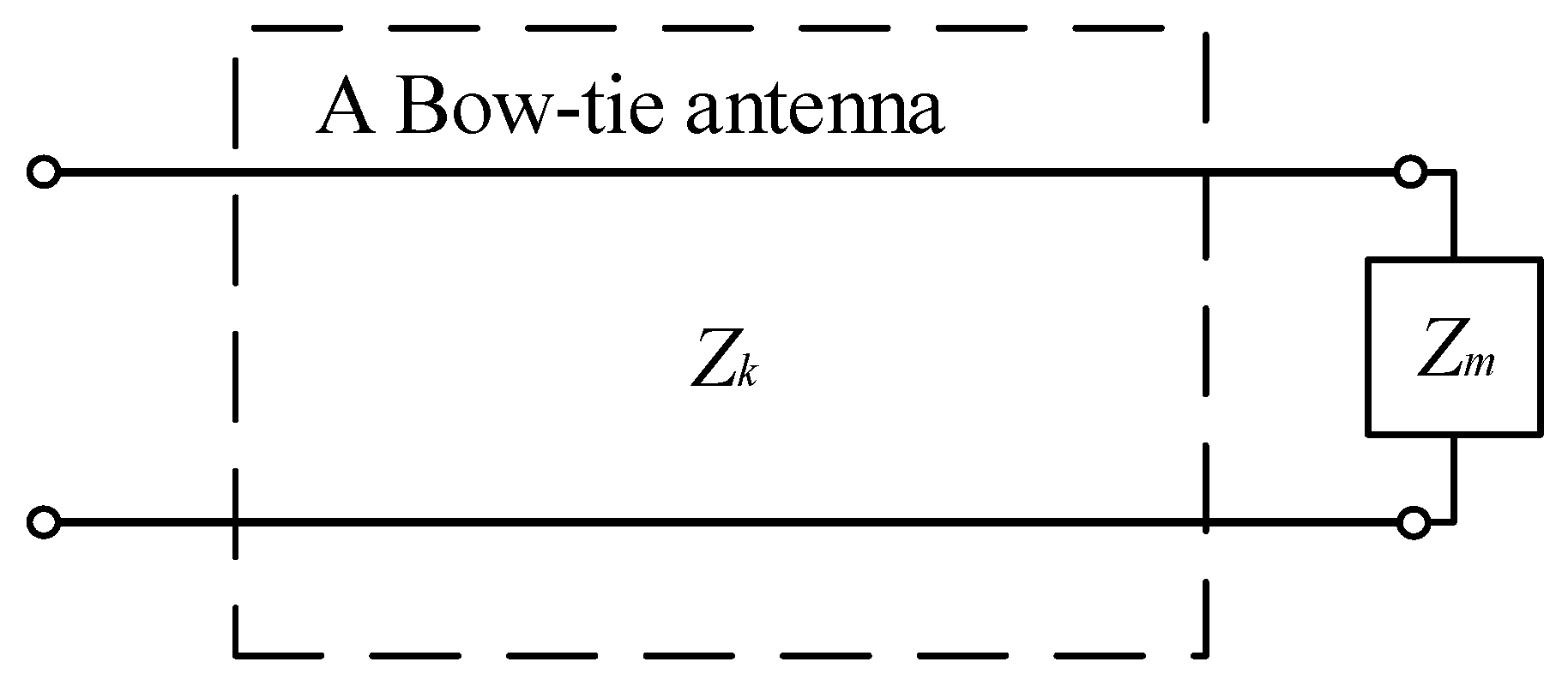
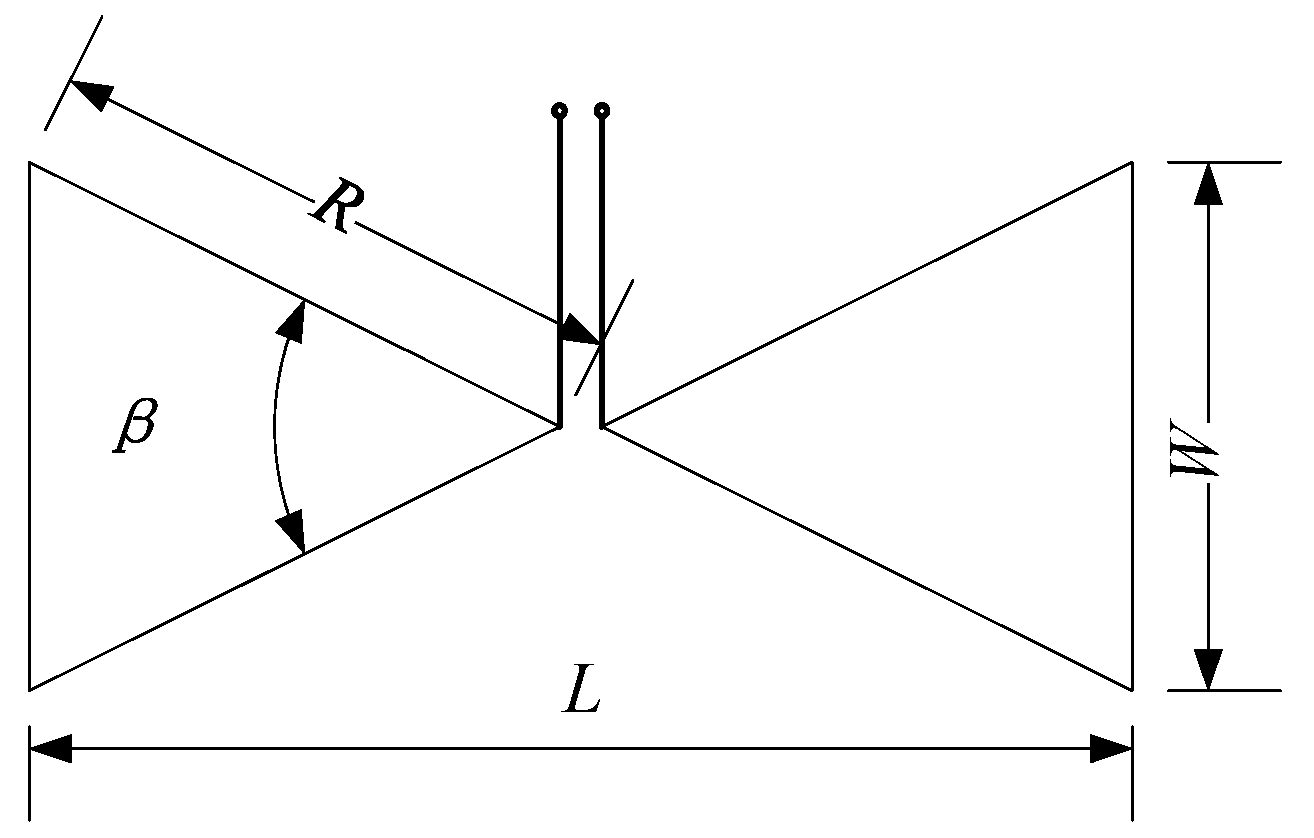



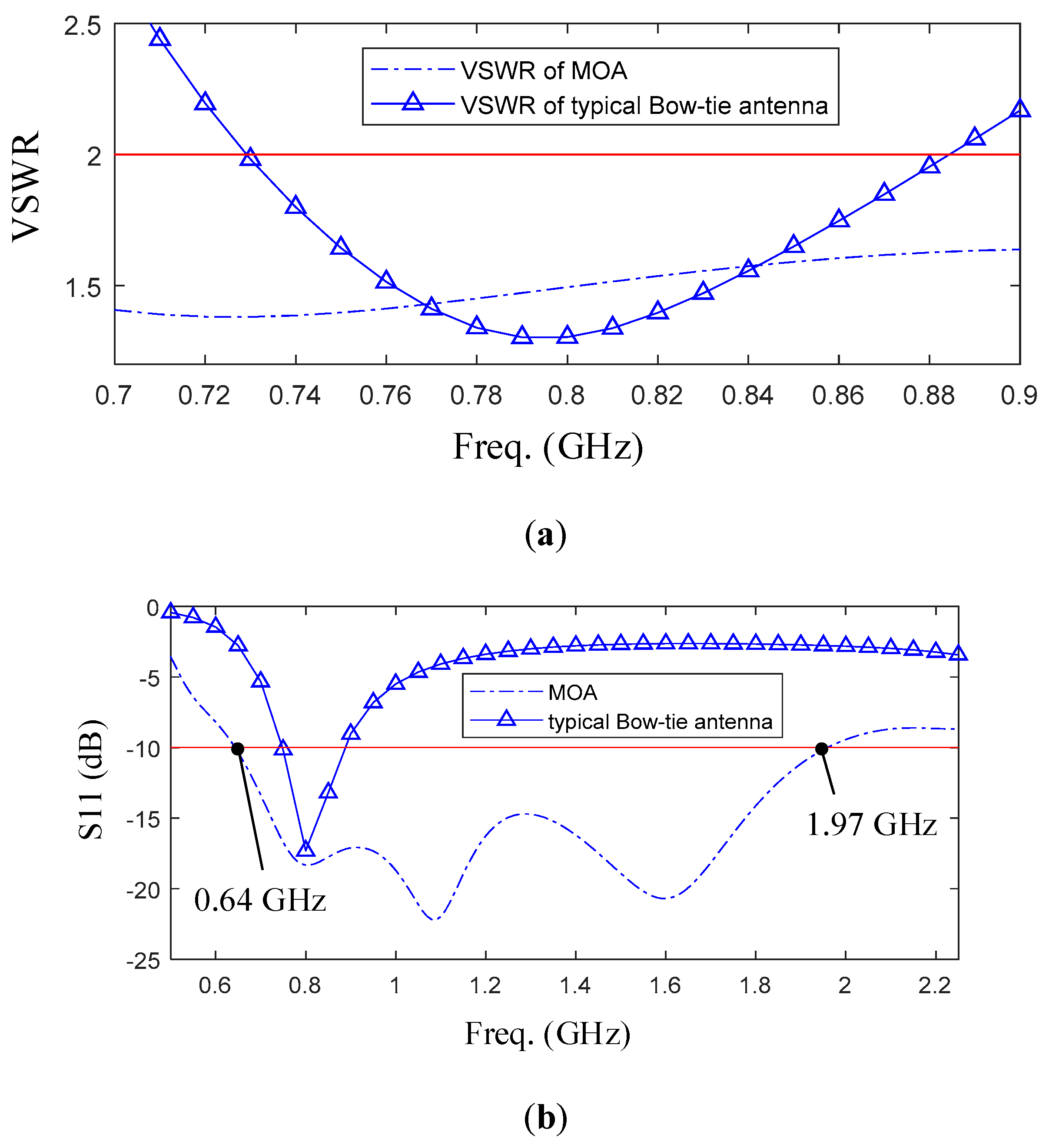



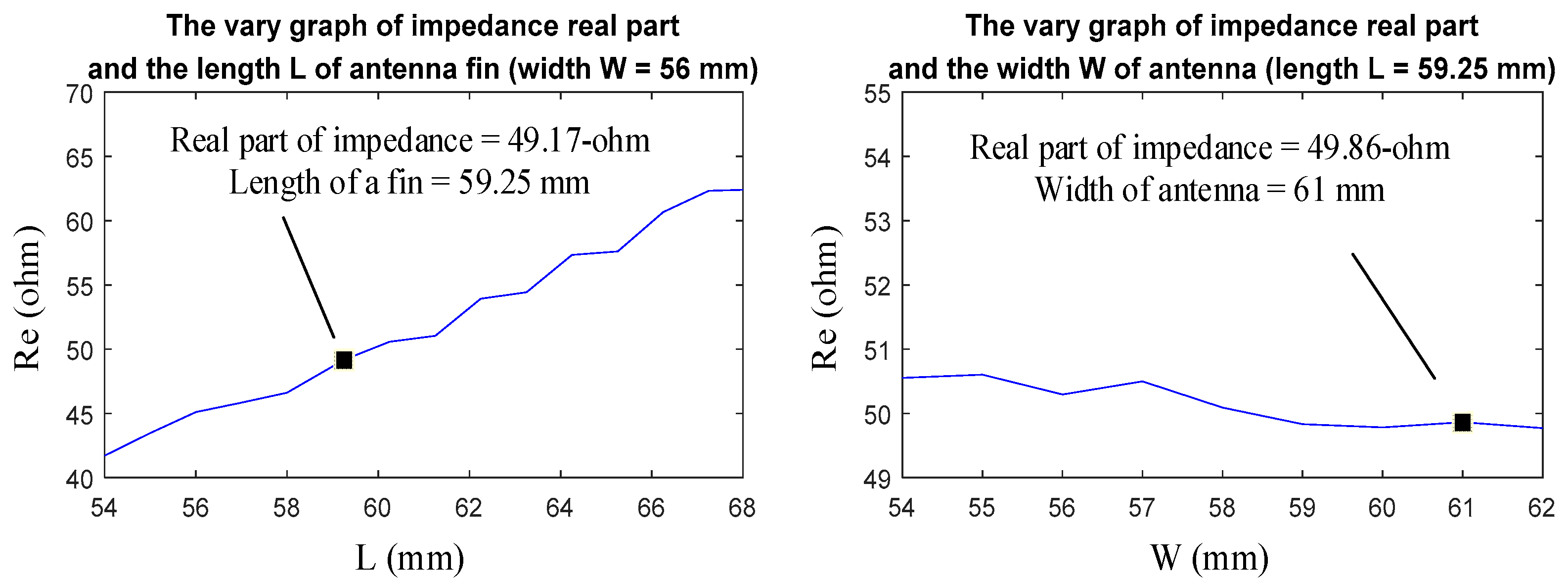
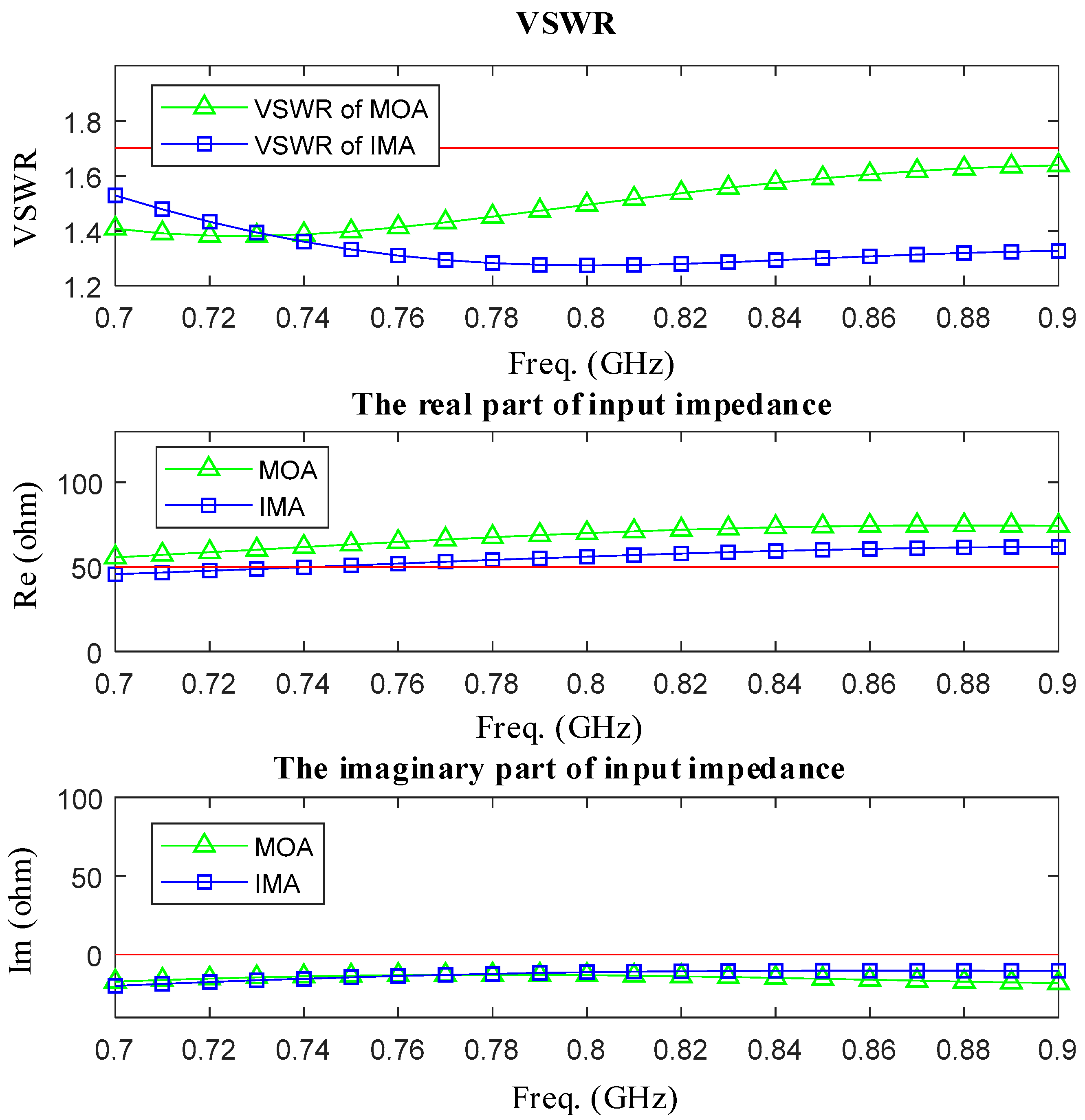
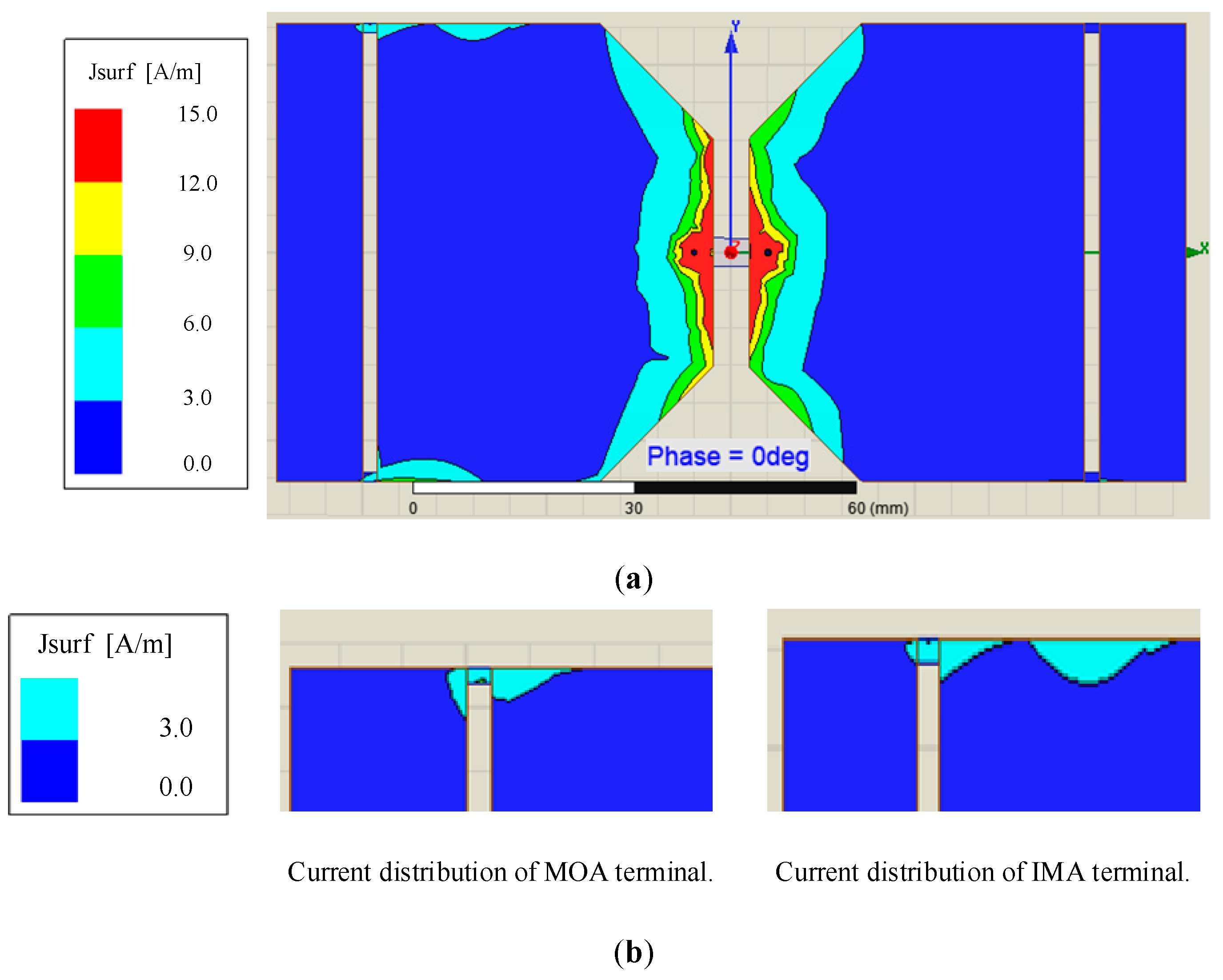
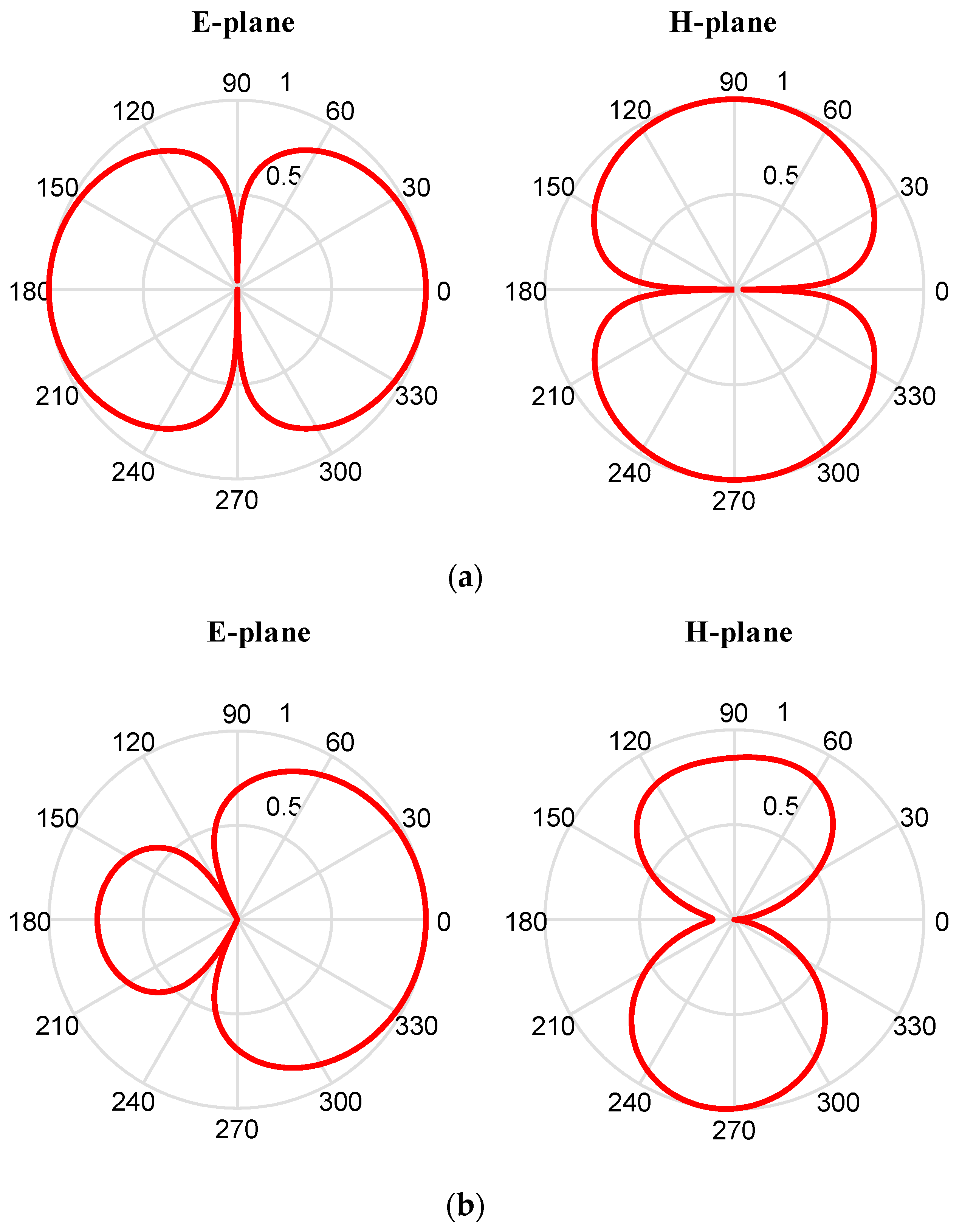
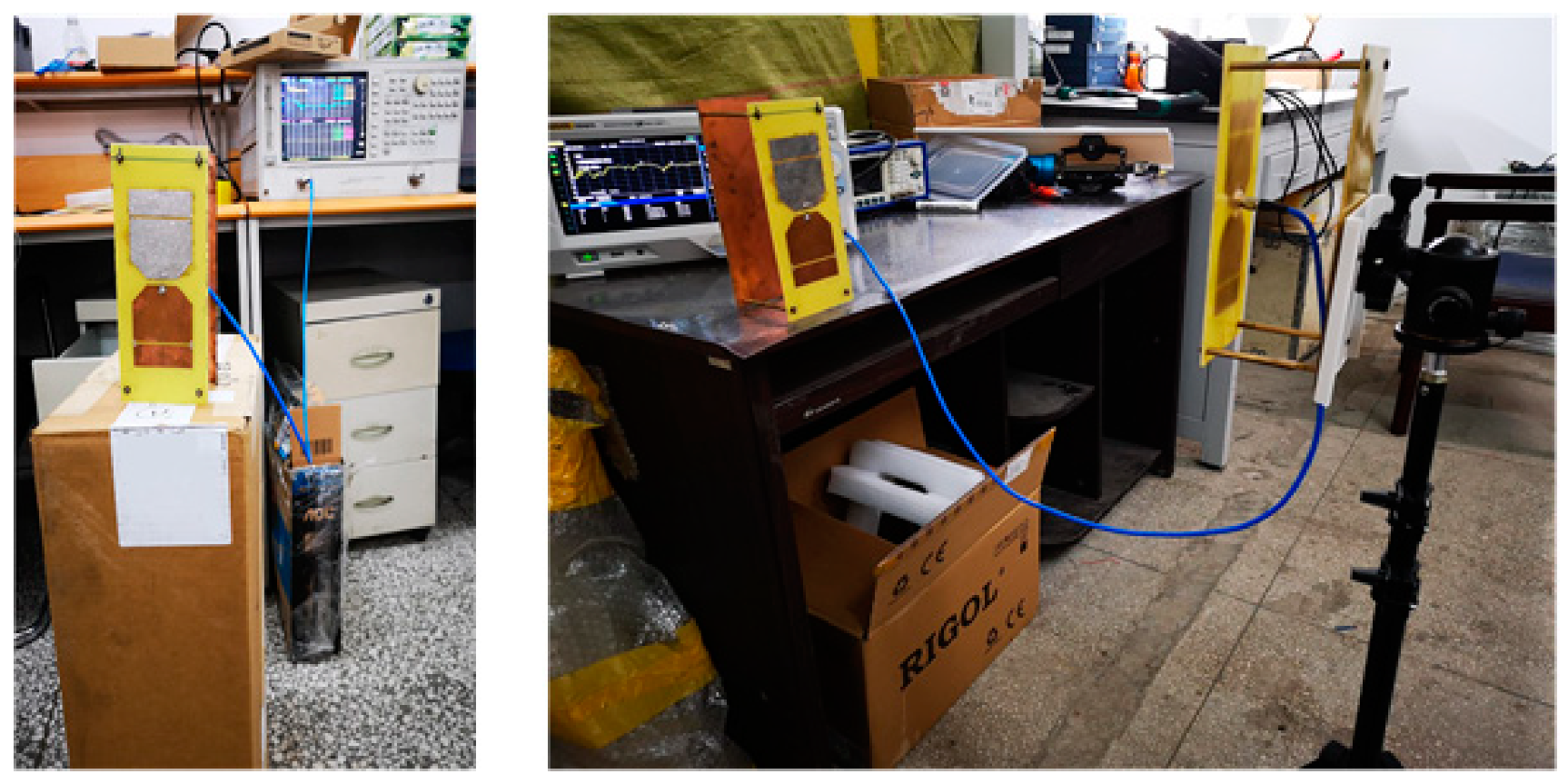
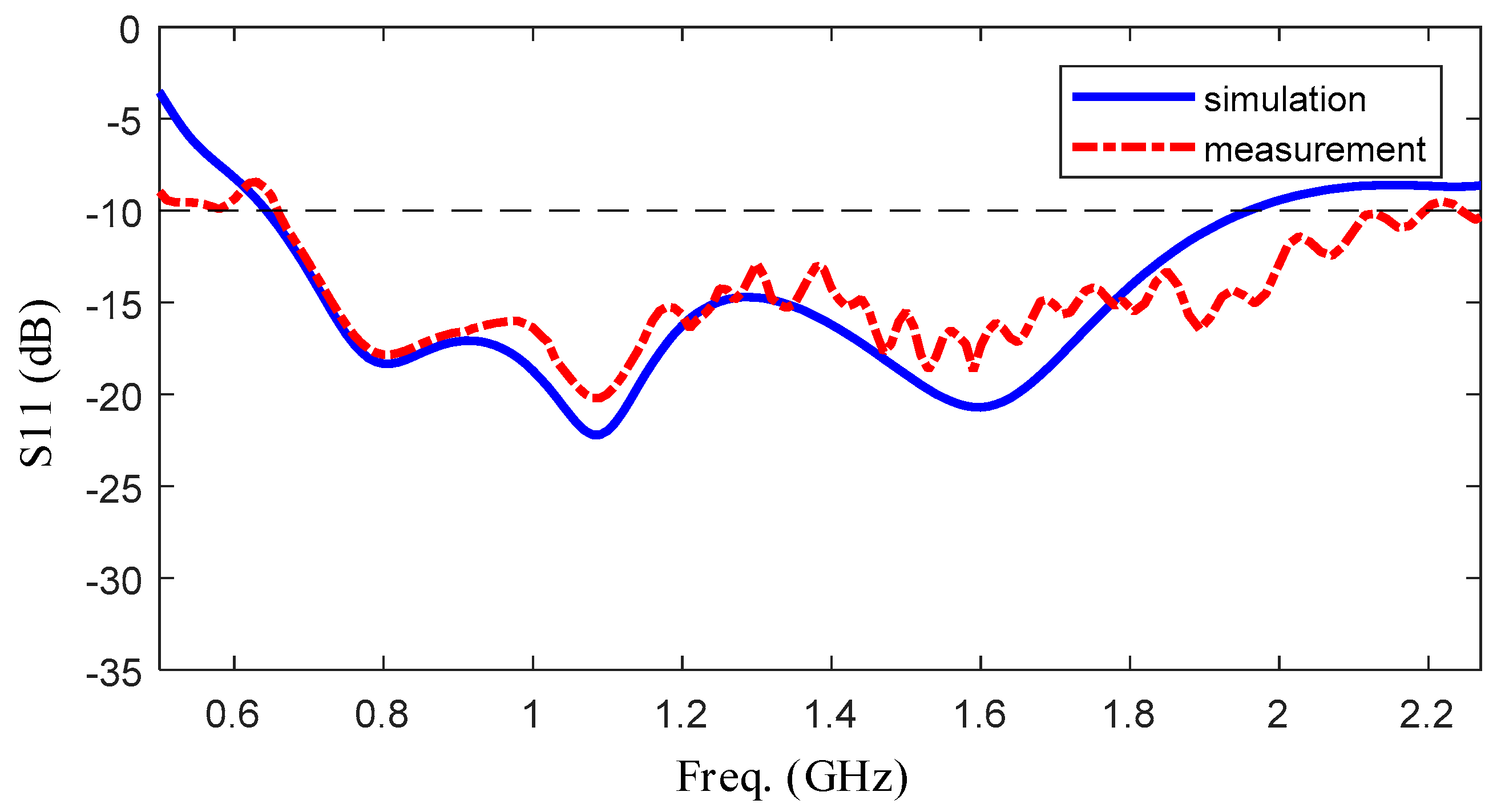

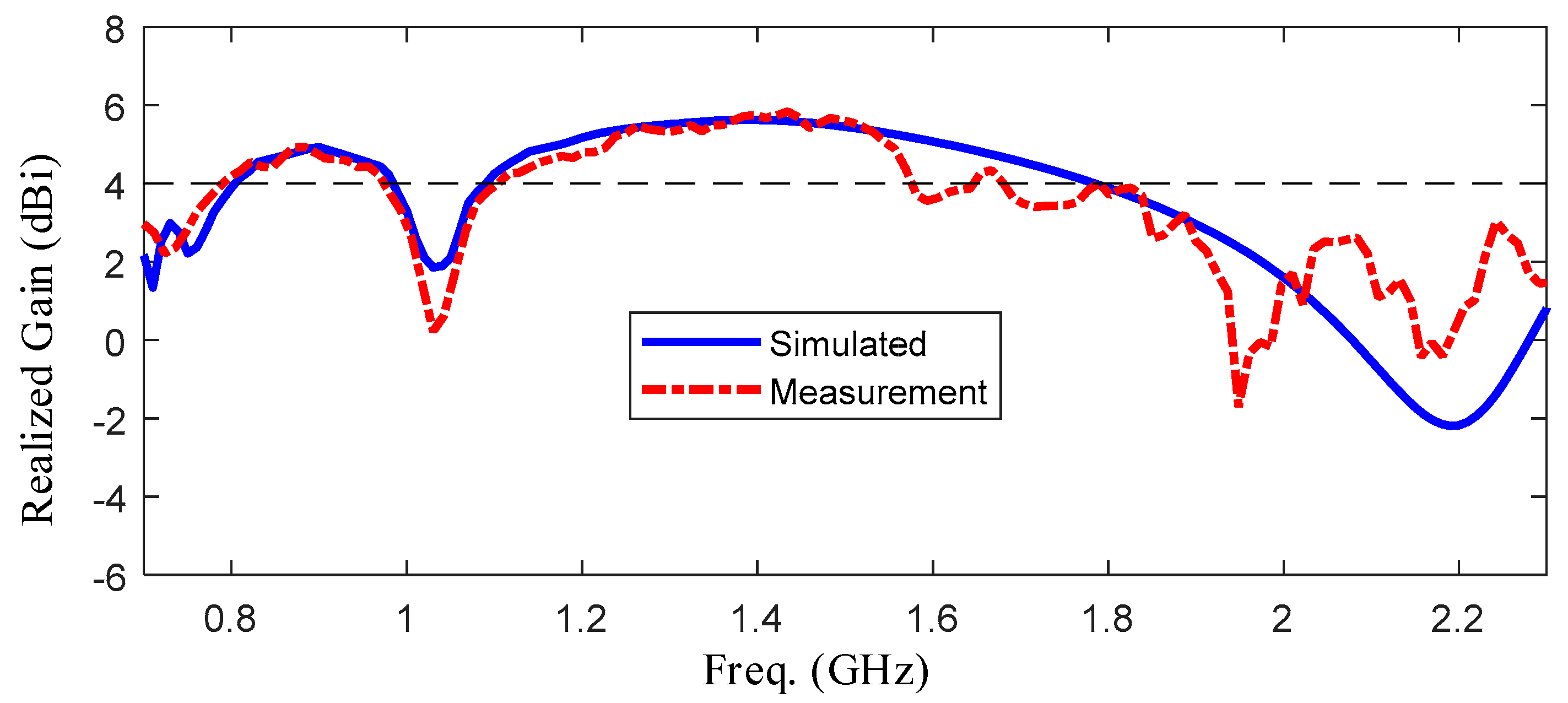
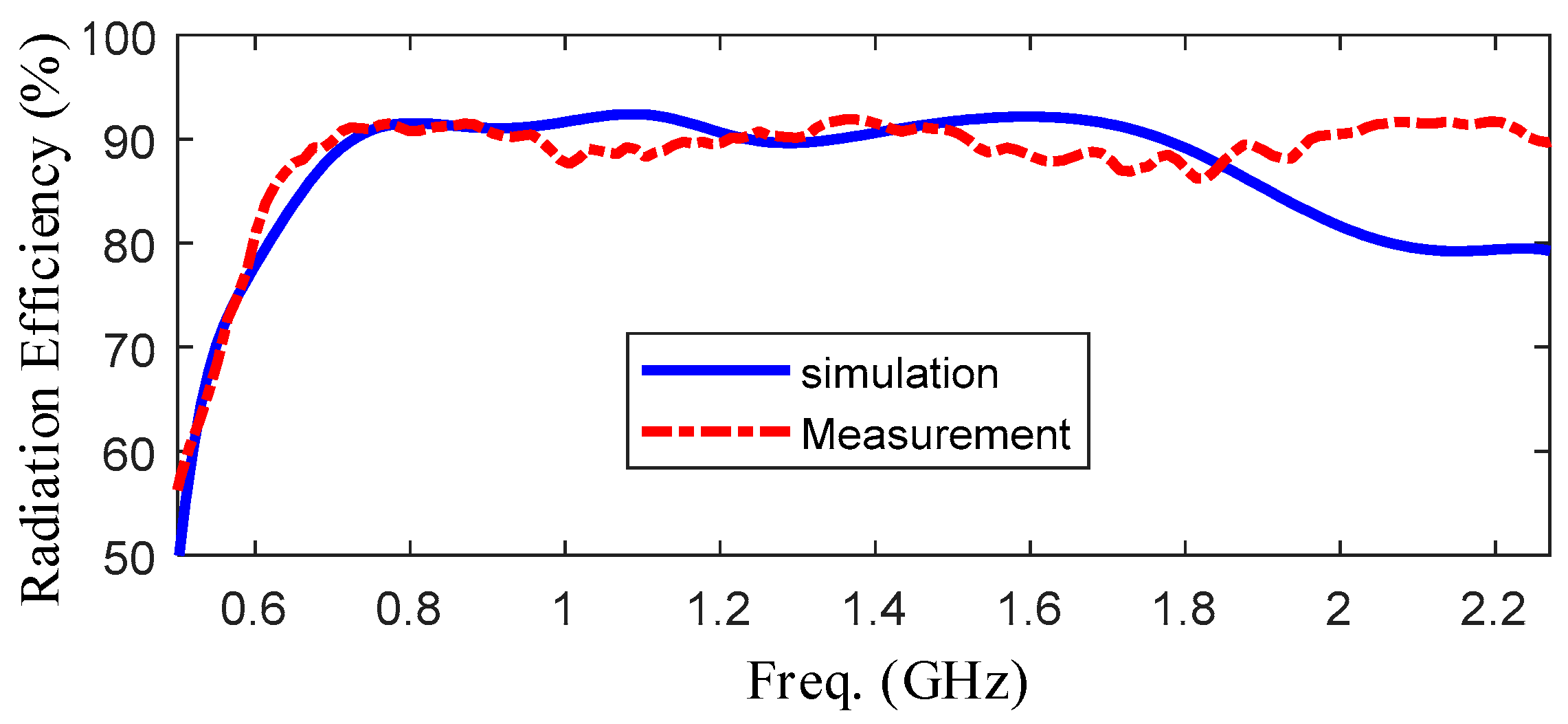
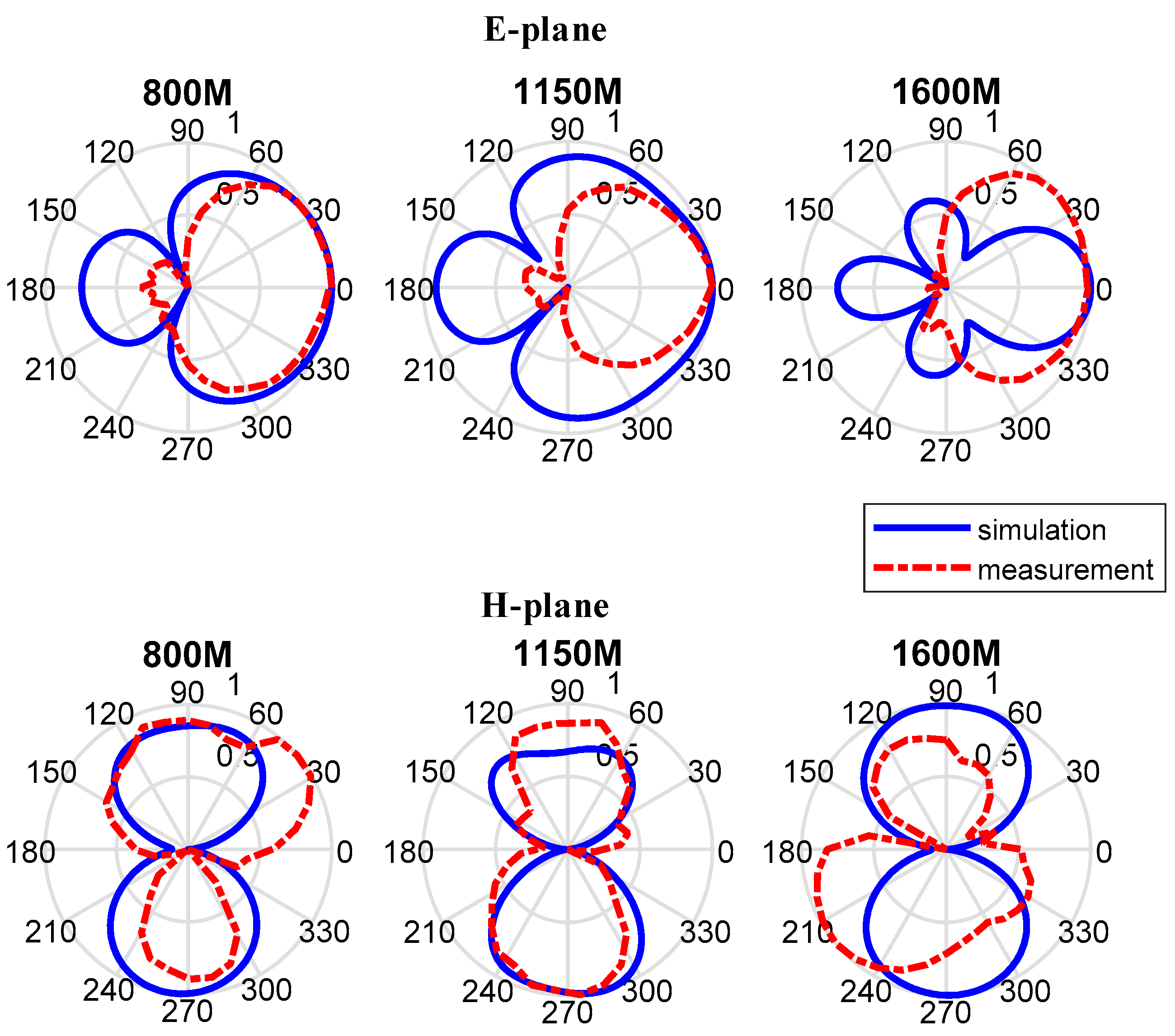


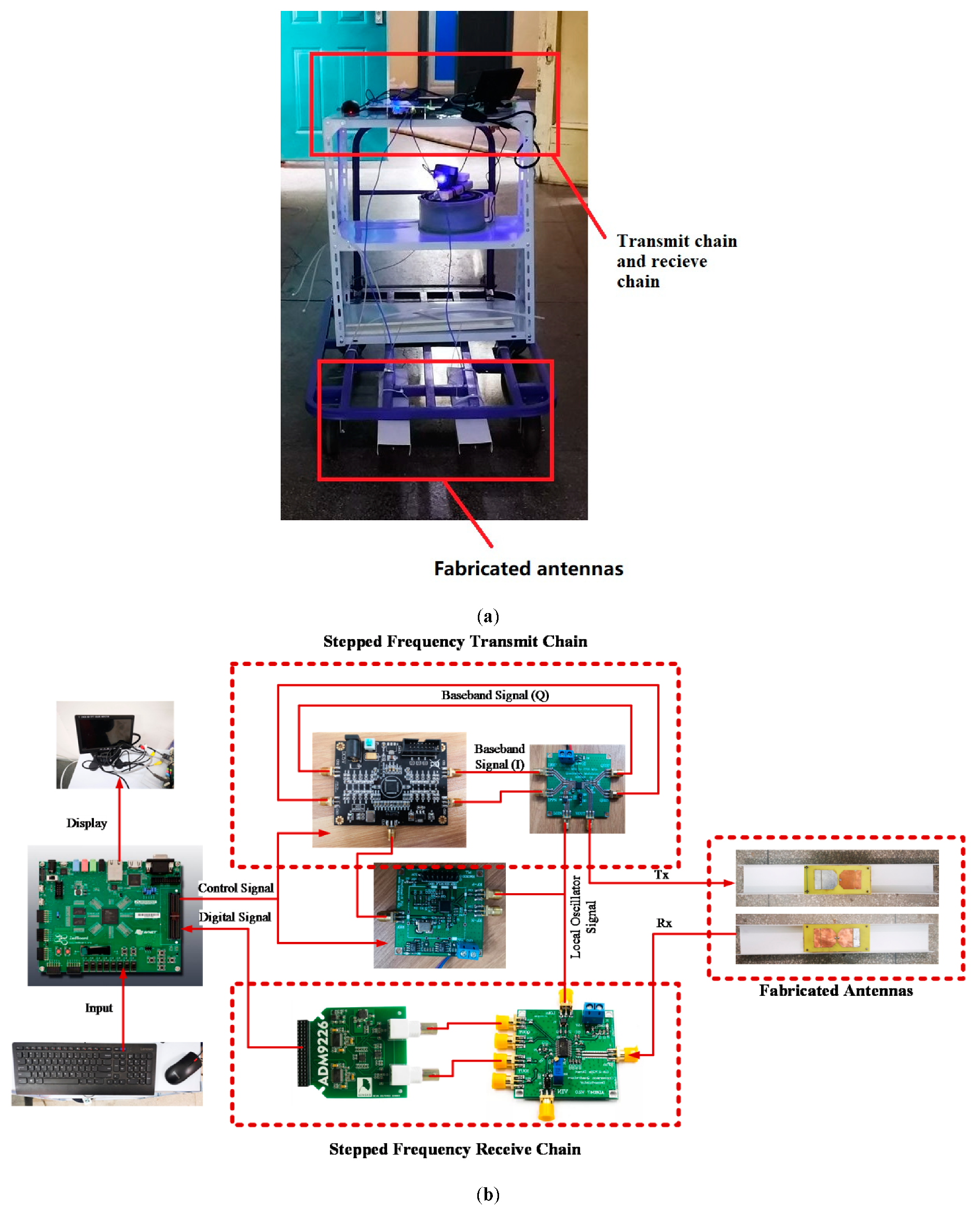

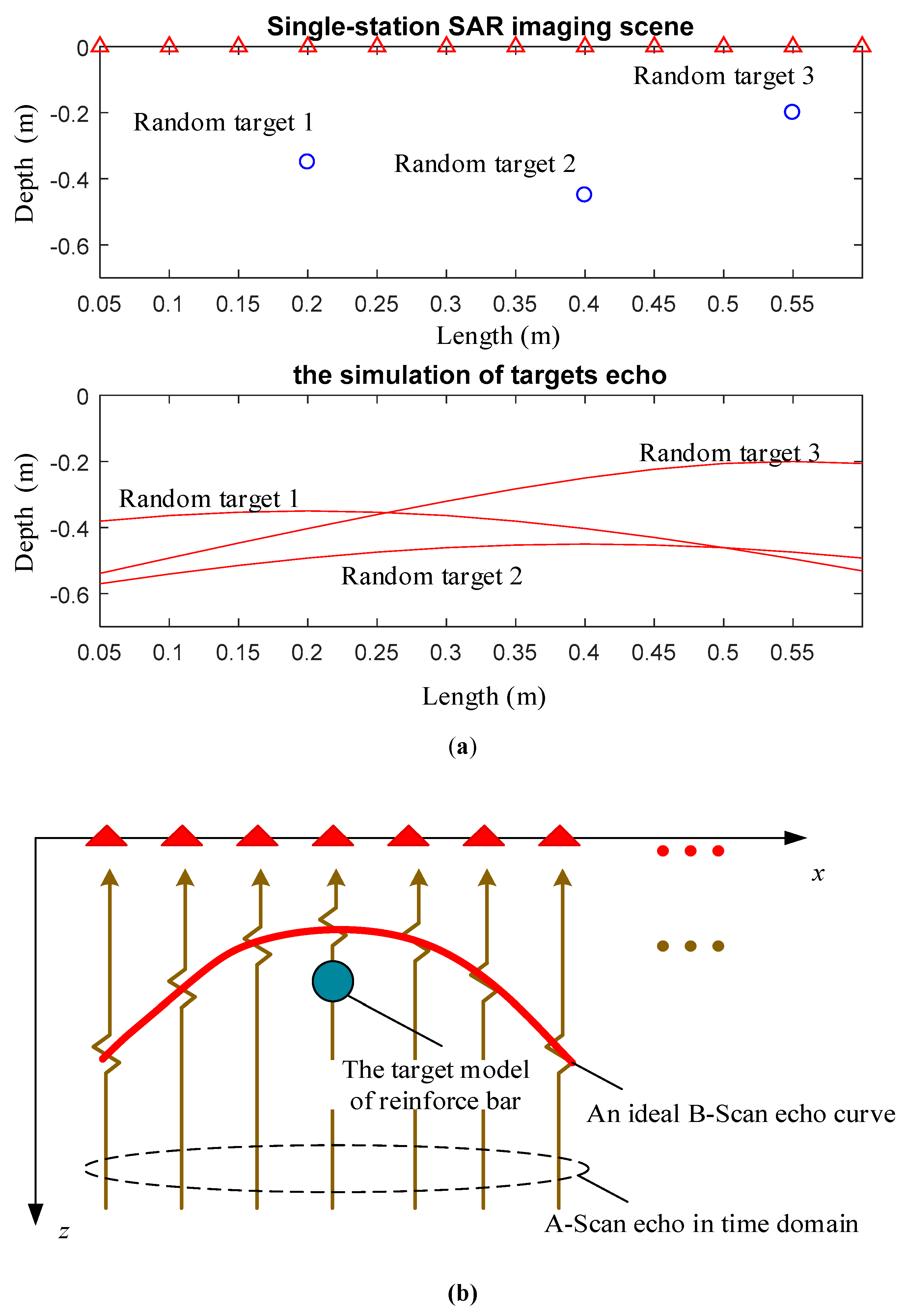
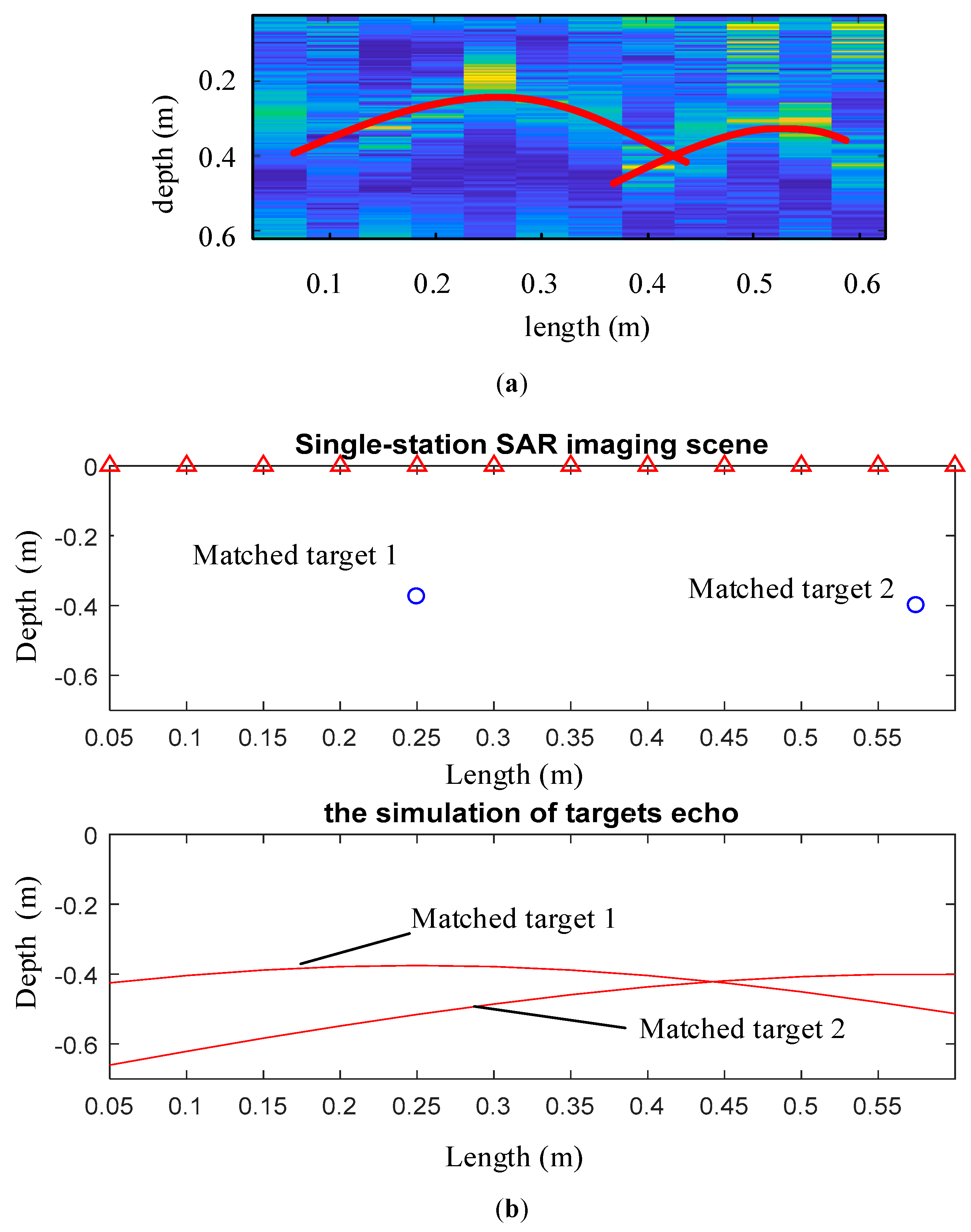
| Band Type | Fractional Bandwidth (BF) |
|---|---|
| Narrowband (NB) | 0.00 < BF < 0.01 |
| Wideband (WB) | 0.01 < BF < 0.25 |
| Ultra-Wideband (UWB) | 0.25 < BF < 2.00 |
| Type of Antenna | Typical Bow-Tie Antenna (800 MHz) | MOA | IMA |
|---|---|---|---|
| Size of Copper Sheet (mm2) | 102 × 57.735 | 127.5 × 56 | 123.5 × 62 |
| Frequency (GHz) | 0.75–0.89 | 0.64–1.96 | 0.64–2.03 |
| Realized Gain (dBi) | −0.67 (0.8 GHz) −0.27 (1.15 GHz) 0.61 (1.60 GHz) | 4.80 (0.8 GHz) 3.26 (1.15 GHz) 4.33 (1.60 GHz) | 3.75 (0.8 GHz) 3.03 (1.15 GHz) 4.57 (1.60 GHz) |
| VSWR | 1.34 (0.8 GHz) 4.79 (1.15 GHz) 6.66 (1.60 GHz) | 1.36 (0.8 GHz) 1.31 (1.15 GHz) 1.14 (1.60 GHz) | 1.28 (0.8 GHz) 1.25 (1.15 GHz) 1.20 (1.60 GHz) |
| Reflection Coefficient (dB) | −16.73 (0.8 GHz) −3.68 (1.15 GHz) −2.63 (1.60 GHz) | −16.19 (0.8 GHz) −17.56 (1.15 GHz) −23.53 (1.60 GHz) | −18.34 (0.8 GHz) −18.97 (1.15 GHz) −20.70 (1.60 GHz) |
| Radiation Efficiency (%) | 95.14% (0.8 GHz) 54.19% (1.15 GHz) 42.56% (1.60 GHz) | 93.53% (0.8 GHz) 93.25% (1.15 GHz) 94.56% (1.60 GHz) | 92.59% (0.8 GHz) 93.73% (1.15 GHz) 94.15% (1.60 GHz) |
| Bandwidth (%) | 17.07% | 101.54% | 104.12% |
| Type of Antenna | Bow-tie antenna | Bow-tie antenna | Bow-tie antenna |
| Parameter | Value |
|---|---|
| Material of substrate | FR-4 |
| Relative permittivity of substrate | 4.4 |
| Substrate dimension | 177.75 × 91.5 × 2 mm3 |
| Height of cavity | 74.25 mm |
| Diameter of copper pillar | 3 mm |
| Length of antenna | 132.5 mm |
| Width of antenna | 56 mm |
| Width of gap | 2 mm |
| Depth of each fin cut out | 54.75 mm |
| Cone angle | 90 degrees |
| Value of resistance | 50-ohm |
| Number of resistances | 4 |
| Width of gap between two fins | 5 mm |
| Parameter | Value |
|---|---|
| the number of stepped frequency pulse (N) | 34 |
| starting frequency (f0) | 700 MHz |
| ending frequency (fn) | 904 MHz |
| stepped frequency interval (Δf) | 6 MHz |
| pulse width (T) | 14 us |
| Ref. No. | [6] | [7] | [8] | This Work |
|---|---|---|---|---|
| Size (mm2) | 36 × 36 | 130 × 130 | 180 × 300 | 177.75 × 91.5 |
| Frequency (GHz) | 2–6 | 2.1–3.1 | 0.26–0.4 | 0.64–2.0 |
| Peak Gain (dBi) | 7.5 | 5.0 | - * | 5.1 |
| Bandwidth (%) | 100% | 39.22% | 42.42% | 103.3% |
| Type of Antenna | planar spiral antenna | Archimedean spiral antenna | half-ellipse antenna | Bow-tie Antenna |
© 2019 by the authors. Licensee MDPI, Basel, Switzerland. This article is an open access article distributed under the terms and conditions of the Creative Commons Attribution (CC BY) license (http://creativecommons.org/licenses/by/4.0/).
Share and Cite
Wu, Y.; Shen, F.; Yuan, Y.; Xu, D. An Improved Modified Universal Ultra-Wideband Antenna Designed for Step Frequency Continuous Wave Ground Penetrating Radar System. Sensors 2019, 19, 1045. https://doi.org/10.3390/s19051045
Wu Y, Shen F, Yuan Y, Xu D. An Improved Modified Universal Ultra-Wideband Antenna Designed for Step Frequency Continuous Wave Ground Penetrating Radar System. Sensors. 2019; 19(5):1045. https://doi.org/10.3390/s19051045
Chicago/Turabian StyleWu, Yuxuan, Feng Shen, Yue Yuan, and Dingjie Xu. 2019. "An Improved Modified Universal Ultra-Wideband Antenna Designed for Step Frequency Continuous Wave Ground Penetrating Radar System" Sensors 19, no. 5: 1045. https://doi.org/10.3390/s19051045




